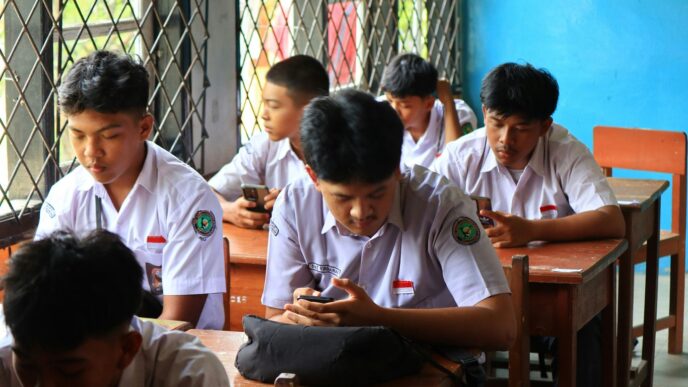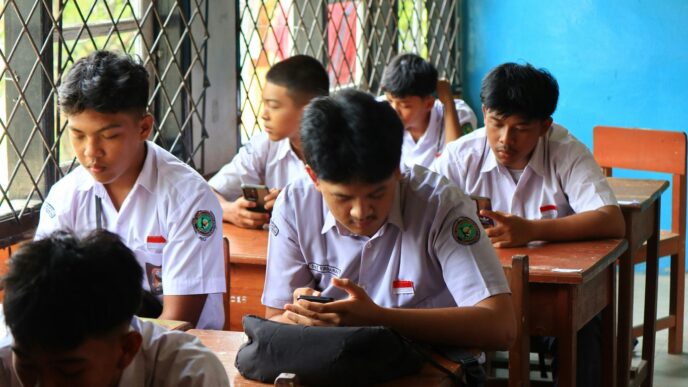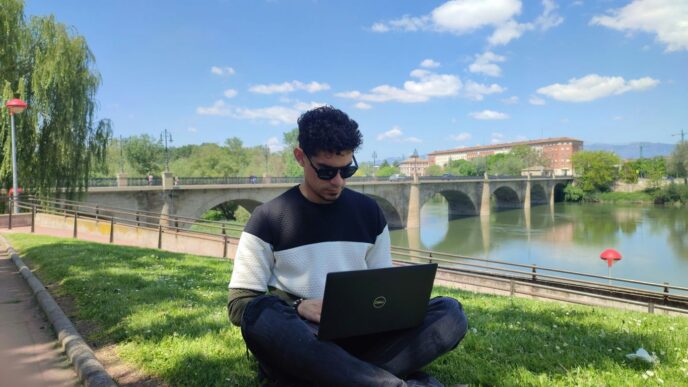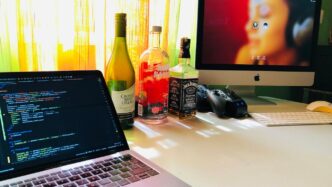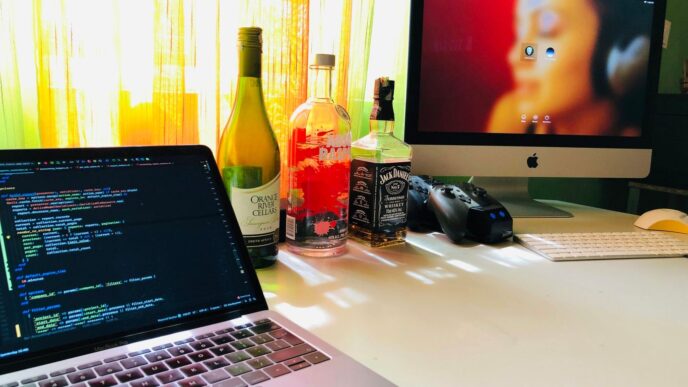In today’s fast-paced digital world, educators are constantly seeking new ways to engage students and enhance learning experiences. Web 2.0 tools have emerged as a powerful resource in the classroom, offering innovative ways to foster collaboration, creativity, and interactive learning. These tools not only allow students to connect and share knowledge but also enable teachers to create dynamic and engaging lesson plans. In this article, we’ll explore how Web 2.0 tools can unlock creativity in the classroom and transform traditional teaching methods.
Key Takeaways
- Web 2.0 tools promote collaboration among students, making group projects more effective.
- Interactive learning through blogs and multimedia presentations can boost student engagement.
- Digital storytelling and content creation tools help students express their creativity.
- Integrating Web 2.0 tools into the curriculum aligns with modern learning objectives.
- Professional development for educators is vital to effectively use these tools in teaching.
Exploring The Landscape Of Web 2.0 Tools
Defining Web 2.0 Tools
Okay, so what are Web 2.0 tools anyway? It’s a term you hear thrown around a lot, but it can be a bit fuzzy. Basically, it refers to a shift in how we use the internet. Think of it as moving from just reading stuff online to actually doing stuff online. Web 2.0 tools are all about interaction, collaboration, and user-generated content. It’s about being active participants, not just passive observers. It’s not a specific software or program, but more of a concept describing how the internet has evolved. It’s the rich interactivity that many online destinations now offer to their members.
Key Features of Web 2.0 Technologies
Web 2.0 technologies have some pretty distinct characteristics. Here’s a quick rundown:
- Collaboration: Think Google Docs, wikis, and shared online workspaces. It’s all about working together in real-time, no matter where you are.
- User-Generated Content: This is huge. Blogs, social media, YouTube – it’s all content created by regular people, not just big corporations. synchronous communication is key.
- Social Networking: Connecting with others, sharing ideas, and building communities online. Facebook, Twitter, Instagram – you know the drill.
- Interactivity: Web 2.0 is dynamic. It’s about real-time updates, comments, and engagement. It’s not just static web pages anymore.
The Evolution of Online Learning Platforms
Online learning has come a long way, and Web 2.0 tools have played a big part. Remember the days of static online courses? Now, it’s all about interactive experiences. Web 2.0 brought community learning and collaborative learning in a social process. We’re talking about:
- Interactive simulations: Students can actively participate in scenarios and experiments.
- Collaborative projects: Students work together on projects, sharing ideas and resources.
- Personalized learning paths: Tailoring the learning experience to individual student needs.
It’s a whole new world of technology integration ideas for education!
Enhancing Collaboration Through Web 2.0 Tools
Web 2.0 tools are really changing how students work together. It’s not just about doing assignments anymore; it’s about building knowledge together. These tools let students connect, share, and create in ways that weren’t possible before. It’s like turning the classroom into a big, interactive workspace.
Social Bookmarking for Group Projects
Social bookmarking is a simple but effective way to organize and share resources. Instead of emailing links back and forth, students can use tools like Diigo or Pocket to save and tag websites, articles, and videos. This makes it easier for everyone in the group to access the same materials and stay on the same page. Think of it as a shared digital library for the project. It’s also a great way to discover new resources that others have found. For example, students working on a project about climate change could use a social bookmarking tool to compile a list of relevant articles, videos, and websites, making it easier for the group to access and share information. This is a great way to improve team collaboration.
Collaborative Document Editing
Gone are the days of emailing Word documents back and forth, with different versions and conflicting edits. Collaborative document editing tools, like Google Docs or Microsoft Word Online, allow multiple students to work on the same document at the same time. This means everyone can see the changes as they happen, and it’s much easier to track who contributed what. It also makes it easier to have real-time discussions and make decisions together. It’s a game-changer for group projects, because it streamlines the writing process and reduces the chances of errors or misunderstandings. It’s also a great way to share resources that enrich the learning experience.
Using Wikis for Knowledge Sharing
Wikis are like online encyclopedias that anyone can edit. They’re a great way for students to create and share knowledge together. Instead of just writing a report, students can contribute to a shared wiki, adding their own research and insights. This encourages teamwork and critical thinking, as students have to evaluate and synthesize information from different sources. It’s also a great way to build a collective understanding of a topic. For example, a group of students might work together to create a wiki on a historical event, with each student responsible for researching and writing about a different aspect of the topic. As the project progresses, students can edit each other’s work, providing feedback and refining their understanding of the subject matter. This is a great way to foster open communication and build a community of practice.
Engaging Students With Interactive Learning

Incorporating Blogs in the Classroom
Okay, so blogs might seem a little old-school, but trust me, they’re still super useful. Think of them as digital notebooks where students can share their thoughts, ideas, and even their struggles. I remember when I first started using blogs in my history class. At first, the students were hesitant, but once they got the hang of it, they really started to open up. They’d post about historical events, analyze primary sources, and even debate different interpretations. It was way more engaging than just reading from a textbook. Plus, it gave them a chance to practice their writing skills in a low-pressure environment. Blogs are great Web 2.0 tools for teachers too, because you can post assignments, share resources, and give feedback all in one place.
Utilizing Multimedia Presentations
Forget boring PowerPoint slides! We’re talking about using videos, animations, and interactive elements to really grab students’ attention. I’ve found that when I incorporate multimedia into my lessons, my students are way more likely to stay focused and retain the information. For example, instead of just lecturing about the water cycle, I show a short animated video that explains the process in a visually appealing way. Or, instead of just reading about famous artists, I show a slideshow of their artwork set to music. It’s all about making the learning experience more dynamic and engaging. Here’s a quick breakdown of how I usually structure my multimedia presentations:
- Start with a captivating visual or sound effect.
- Keep the text concise and easy to read.
- Incorporate interactive elements like quizzes or polls.
Creating Interactive Quizzes and Polls
Let’s be real, traditional quizzes can be a drag. But what if you could make them fun and engaging? That’s where interactive quizzes and polls come in. There are tons of online tools that let you create quizzes with different question types, like multiple choice, true/false, and even fill-in-the-blank. You can also add images, videos, and audio clips to make them more visually appealing. And the best part? You can get instant feedback on how your students are doing. Polls are also a great way to get students involved in the learning process. You can use them to gauge their understanding of a topic, spark discussions, or even just get their opinions on a particular issue. I use online learning platforms to create interactive quizzes and polls.
Fostering Creativity With Web 2.0 Tools
Web 2.0 tools aren’t just about collaboration and communication; they’re also amazing for sparking creativity in students. It’s about giving them the means to express themselves in ways that go beyond traditional pen and paper. I think that’s pretty cool.
Digital Storytelling Applications
Digital storytelling is where it’s at! It lets students weave narratives using a mix of images, audio, and video. Think of it as taking show and tell to a whole new level. Instead of just standing in front of the class, they can create compelling stories that really grab attention. There are a bunch of user-friendly apps out there that make it easy, even if you’re not a tech whiz. It’s a great way to get them thinking about plot, character development, and all that good stuff. Plus, it helps them develop their tech skills without even realizing it. A website-based learning model can really help with this.
Visual Content Creation Tools
Forget boring presentations! Visual content creation tools let students design infographics, posters, and even short animations. These tools often have drag-and-drop interfaces, so it’s super easy to create something that looks professional. I’ve seen students use these to explain complex topics in a way that’s both informative and visually appealing. It’s all about making learning fun and engaging. Here are some ideas:
- Canva: Great for creating posters and infographics.
- Piktochart: Another good option for infographics.
- Animaker: For making short animated videos.
Music and Video Editing Software
Okay, this is where things get really interesting. Music and video editing software lets students create their own soundtracks or edit video footage to tell a story. It might sound intimidating, but there are plenty of beginner-friendly programs out there. Imagine students creating a music video for a history project or composing a soundtrack for a science presentation. It’s all about letting them explore their creative side and express themselves in new and exciting ways. It’s a great way to get them excited about learning. I think that’s pretty neat.
Integrating Web 2.0 Tools Into Curriculum
Aligning Tools With Learning Objectives
Okay, so you’re all excited about using the latest Web 2.0 tools in your classroom. That’s great! But before you just jump in, it’s super important to make sure these tools actually help you reach your teaching goals. Think about what you want your students to learn and then find the tools that fit those needs. Don’t just use a tool because it’s cool; use it because it makes learning better. For example, if you want students to collaborate on a writing project, a collaborative document editing tool makes sense. If you want them to learn about current events, maybe a blog or news aggregator is the way to go. It’s all about matching the tool to the task. This approach ensures that technology integration in education web-based materials is meaningful and not just tech for tech’s sake.
Strategies for Effective Implementation
Alright, you’ve picked your tools, now what? Here’s the thing: just throwing a tool at your students and hoping they figure it out isn’t going to cut it. You need a plan! Start small. Introduce one tool at a time. Give clear instructions. Model how to use the tool. Provide support when students get stuck. And don’t forget to build in time for practice. Think of it like teaching any other skill. You wouldn’t expect students to master algebra after one lesson, right? Same goes for Web 2.0 tools. Also, consider scaffolding activities. Start with simple tasks and gradually increase the complexity as students become more comfortable. Here’s a possible timeline:
| Week | Activity | Tool(s) Used |
|---|---|---|
| 1 | Introduction to the tool | (e.g., Padlet) |
| 2 | Simple brainstorming activity | Padlet |
| 3 | Collaborative project planning | Padlet, Google Docs |
| 4 | Project execution and presentation | Various |
Assessing Student Engagement and Outcomes
So, you’ve been using these Web 2.0 tools for a while now. How do you know if they’re actually working? Well, you need to assess student engagement and learning outcomes. This doesn’t just mean giving a test at the end of the unit. It means using a variety of methods to see how students are doing along the way. Here are some ideas:
- Observe student participation: Are students actively using the tools? Are they collaborating effectively? Are they asking questions and seeking help when needed?
- Review student work: Are students producing high-quality work using the tools? Are they demonstrating a deeper understanding of the concepts?
- Collect student feedback: Ask students what they think of the tools. What do they like? What do they dislike? What could be improved? You can use surveys, focus groups, or even just informal conversations. Social bookmarking tools useful resources can help students organize research materials, share relevant articles or websites, and collaborate on finding new resources.
- Use analytics: Some Web 2.0 tools have built-in analytics that can track student activity and progress. Use this data to identify areas where students are struggling and adjust your instruction accordingly. Remember, assessment should be ongoing and informative. It’s not just about giving grades; it’s about helping students learn and grow. By using a variety of assessment methods, you can get a more complete picture of student engagement and outcomes and make informed decisions about how to use Web 2.0 tools in your classroom.
Professional Development for Educators
Okay, so you’re thinking about using Web 2.0 tools in your classroom? Awesome! But let’s be real, just throwing a bunch of new tech at teachers without any support is a recipe for disaster. That’s where professional development comes in. It’s not just about learning how to click buttons; it’s about understanding how these tools can actually improve teaching and learning.
Training Teachers on Web 2.0 Tools
First things first, teachers need actual training. Not just a one-hour webinar, but real, hands-on experience. Think workshops where they can play around with the tools, try out different activities, and ask questions. It’s about making them comfortable and confident. The goal is to move beyond basic functionality and explore creative applications within their specific subject areas. For example, a history teacher might learn how to use digital timelines to bring historical events to life, while a science teacher could use interactive simulations to explain complex concepts.
Building a Community of Practice
Learning shouldn’t stop after the workshop. Creating a community of practice where teachers can share ideas, ask for help, and learn from each other is super important. This could be an online forum, regular meetings, or even just a shared Google Doc where everyone can contribute. It’s about building a supportive network where teachers feel comfortable experimenting and taking risks. I think that’s really important.
Sharing Best Practices and Resources
No one wants to reinvent the wheel. So, let’s make sure teachers have access to a library of best practices and resources. This could include lesson plans, tutorials, and examples of how other teachers are using Web 2.0 tools in their classrooms. It’s about curating the best stuff and making it easy for teachers to find what they need. Maybe even a table like this:
| Resource Type | Description | Example |
|---|---|---|
| Lesson Plans | Ready-to-use activities | Using Google Earth for Geography |
| Tutorials | Step-by-step guides | Creating Interactive Quizzes with Quizizz |
| Case Studies | Examples of successful implementation | How a school increased engagement with instructional technology strategies |
Challenges and Considerations in Using Web 2.0 Tools
Addressing Digital Divide Issues
Okay, so Web 2.0 tools are cool and all, but let’s be real – not everyone has the same access. The digital divide is still a huge problem. Some students have lightning-fast internet and the latest gadgets, while others are stuck with dial-up (yes, it still exists!) or have to share a device with their whole family. This creates an uneven playing field, and we need to be mindful of that. It’s not fair to expect everyone to participate equally if they don’t have the same resources. We need to find ways to bridge this gap, whether it’s providing devices, offering offline alternatives, or ensuring that assignments can be completed with limited bandwidth. It’s about making sure everyone has a fair shot, regardless of their socioeconomic background. This is where ICT solutions come in handy.
Ensuring Student Privacy and Safety
Alright, let’s talk about the scary stuff: student privacy and safety. When we’re using Web 2.0 tools, we’re often asking students to share personal information online, whether it’s creating a profile, posting comments, or uploading content. We need to be super careful about protecting their data and making sure they’re not exposed to inappropriate content or online predators. This means having clear guidelines about what’s okay to share and what’s not, using privacy settings, and monitoring online activity. It also means teaching students about digital citizenship and how to stay safe online. It’s a big responsibility, but it’s one we can’t afford to take lightly. Here are some things to keep in mind:
- Use platforms with strong privacy settings.
- Educate students about online safety.
- Monitor online interactions.
- Get parental consent when necessary.
Evaluating Tool Effectiveness and Usability
So, you’ve found a shiny new Web 2.0 tool that promises to revolutionize your classroom. Awesome! But before you jump in headfirst, take a step back and ask yourself: Does this thing actually work? Is it easy to use? And most importantly, is it helping my students learn? Not all tools are created equal, and some are just plain clunky or confusing. It’s important to evaluate the effectiveness and usability of any tool before you make it a regular part of your curriculum. This means trying it out yourself, getting feedback from students, and looking at the data to see if it’s actually improving learning outcomes. Don’t be afraid to ditch a tool if it’s not working – there are plenty of others out there. It’s all about finding what works best for you and your students.
Wrapping It Up
In the end, Web 2.0 tools are game changers for classrooms. They make learning more interactive and fun, letting students take charge of their education. With platforms like blogs, wikis, and social media, students can share ideas and work together like never before. This shift not only keeps them engaged but also helps them pick up important skills they’ll need in the real world. As we look ahead, it’s clear that embracing these tools can lead to a more vibrant and effective learning environment for everyone involved.
Frequently Asked Questions
What are Web 2.0 tools?
Web 2.0 tools are online applications that let users create, share, and collaborate easily. They include blogs, wikis, social media, and more.
How can Web 2.0 tools help in the classroom?
These tools make learning more interactive and engaging. They allow students to work together on projects, share ideas, and create content.
What are some examples of Web 2.0 tools?
Examples include Google Docs for document collaboration, Edmodo for classroom communication, and Prezi for presentations.
How do I keep students safe when using Web 2.0 tools?
It’s important to teach students about online safety. Use privacy settings, monitor their activities, and encourage them to think critically about what they share.
Can Web 2.0 tools be used for all subjects?
Yes! These tools are versatile and can be applied across different subjects to enhance learning and creativity.
What challenges might teachers face when using Web 2.0 tools?
Teachers may encounter issues like lack of training, technology access problems, and ensuring that all students are engaged.






